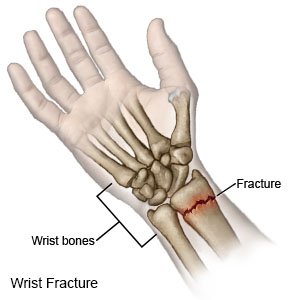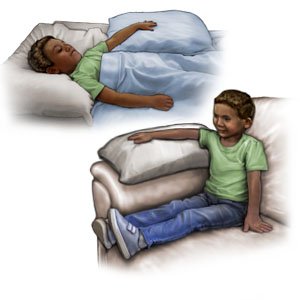Wrist Fracture in Children
Medically reviewed by Drugs.com. Last updated on Aug 4, 2025.
AMBULATORY CARE:
A wrist fracture
is a break in one or more of the bones in your child's wrist.
 |
Signs and symptoms:
- Pain, swelling, and bruising of the wrist
- Wrist pain that is worse when your child holds something or puts pressure on the wrist
- Weakness, numbness, or tingling in the hand or wrist
- Trouble moving the wrist, hand, or fingers
- A change in the shape of the wrist
Seek care immediately if:
- Your child's pain gets worse or does not get better after he or she takes pain medicine.
- Your child's cast or splint breaks, gets wet, or is damaged.
- Your child tells you that his or her hand or fingers feel numb or cold.
- Your child's hand or fingers turn white or blue.
- Your child says that his or her splint or cast feels too tight.
- Your child's pain or swelling gets worse after the cast or splint is put on.
Call your child's doctor or bone specialist if:
- Your child has a fever.
- There is a foul smell or blood coming from under the cast.
- You have questions or concerns about your child's condition or care.
Treatment for a wrist fracture
will depend on which wrist bone was broken and the kind of fracture your child has. Your child may need any of the following:
- Medicine may be given to decrease pain and swelling. Your child may need antibiotic medicine or a tetanus shot if there is a break in his or her skin.
- A cast, splint, or brace may be placed on your child's wrist to decrease movement. These devices will help hold the bones in place while they heal.
- Traction may be needed if your child's bones broke into 2 pieces. Traction pulls on the bones to pull them back into place. A pin may be put in your child's bone or cast and hooked to ropes and a pulley. Weight is hung on the rope to help pull on the bones so they will heal correctly.
- A closed reduction is a procedure to put your child's bones into the correct position without surgery.
- Surgery may be needed to put your child's bones back into the correct position. Wires, pins, plates or screws may be used to help hold the bones in place.
Care for your child:
- Have your child rest as much as possible. Do not let your child play contact sports until the healthcare provider says it is okay.
- Apply ice on your child's wrist for 15 to 20 minutes every hour or as directed. Use an ice pack, or put crushed ice in a plastic bag. Cover it with a towel before you place it on your child's skin. Ice helps prevent tissue damage and decreases swelling and pain.
- Elevate your child's wrist above the level of his or her heart as often as possible. This will help decrease swelling and pain. Prop your child's wrist on pillows or blankets to keep it elevated comfortably.

Cast or splint care:
- Your child may take a bath as directed. Do not let your child's cast or splint get wet. Before bathing, cover the cast or splint with 2 plastic trash bags. Tape the bags to your child's skin above the cast or splint to seal out the water. Have your child keep his or her arm out of the water in case the bag breaks. If a plaster cast gets wet and soft, call your child's healthcare provider.
- Check the skin around the cast or splint every day. You may put lotion on any red or sore areas.
- Do not let your child push down or lean on the cast or brace because it may break.
- Do not let your child scratch the skin under the cast by putting a sharp or pointed object inside the cast.
Take your child to physical therapy as directed:
Your child may need physical therapy after his or her wrist has healed and the cast is removed. A physical therapist teaches your child exercises to help improve movement and strength, and to decrease pain.
Follow up with your child's doctor or bone specialist as directed:
Your child may need to return to have his or her cast removed. He or she may also need an x-ray to check how well the bone has healed. Write down your questions so you remember to ask them during your visits.
© Copyright Merative 2025 Information is for End User's use only and may not be sold, redistributed or otherwise used for commercial purposes.
The above information is an educational aid only. It is not intended as medical advice for individual conditions or treatments. Talk to your doctor, nurse or pharmacist before following any medical regimen to see if it is safe and effective for you.
Learn more about Wrist Fracture
Treatment options
Care guides
Symptoms and treatments
Medicine.com guides (external)
Further information
Always consult your healthcare provider to ensure the information displayed on this page applies to your personal circumstances.
